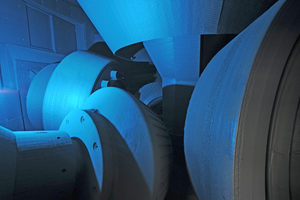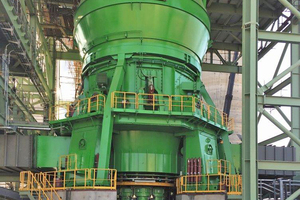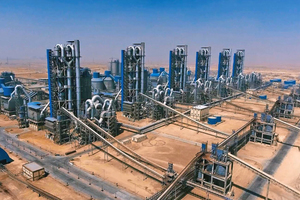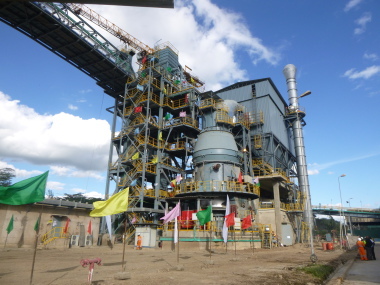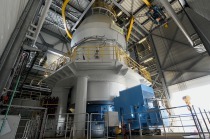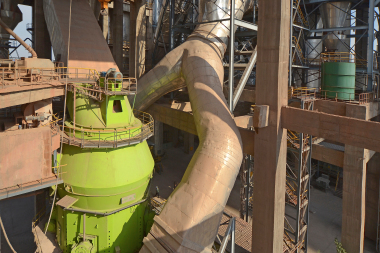More than 400 vertical roller mills for cement and granulated blast furnace slag grinding sold
Loesche has already sold more than 400 clinker and slag mills worldwide.
The most recent CS mills – 2x LM 53.3+3 CS – were sold to the Pakistani cement manufacturer, Kohat Cement Company Limited. The plant is expected to produce 210 t/h of Portland cement at a fineness of 98 % R 45 μm.
The first Loesche LM 35.2+2 mill went into operation in Fos sur Mer in France in 1994. Just 10 years later (2004), a total of 50 plants of various sizes had been sold for the production of cement powder and granulated blast furnace slag. And in the next two years (until 2006), 50 more mills had been sold. In the second quarter of 2014 over 300 vertical roller mills of this type were in operation or construction.
In the last four years, a further 100 mills were sold.
History
The grinding of clinker and cement and of granulated blast furnace slag and slag in vertical air-swept grinding mills dates back to Ernst Curt Loesche’s invention. In 1927, he applied for a patent for the world’s first spring-loaded air-swept mill – the beginning of the triumph that is Loesche vertical roller mills. The patent was granted in 1928 – which means 90 years of the modern Loesche mill. As early as 1935 Ernst Curt Loesche sold the first Loesche cement mill LM 11 type in Brazil. However, it was 50 years until it was able to assert itself on a larger scale.
At this time the cement industry also wanted to produce cement with the help of roller comminution which required less energy. And even though the entire cement manufacturing process was being constantly optimised, the energy-intensive clinker brick grinding process had long since been ruled out.
The reason: The requirement for the high fineness of particles led to a dust/air mixture in the vertical roller mill, which made the grinding bed formation in the rollers difficult. For this reason, in conventional plants, each roller had to not only provide the actual communition but also the preparation of the internal grinding beds using pre de-aeration and precompaction. This caused the mill to vibrate significantly due to inadequate grinding bed formation, causing disrupted mill operation and unreliable variations in the fineness of the particles, so that the high quality requirements of the end product could not be adhered to.
This discovery lead to the development of the patented mills for pulverization: the Loesche LM-CS series (cement/slag).
With the M+S technology developed by Loesche, these mills separate the preparation and grinding stages of the process and establish an entirely new grinding-roller concept. Technically, a corresponding number of preparation or support rollers (S) are implemented in the grinding or master rollers (M), that take over the grinding bed preparation (the 2+2, 3+3 or 4+4 technology depending on the throughput). As a result, the specific properties of the very fine material can be reliably controlled. With this invention, Loesche has, for decades, been in the position to replace conventional grinding technology in the cement industry with vertical air-swept grinding mills. This technology is also used in the grinding of steel slag.
Advantages
The 2+2, 3+3 and 4+4 technology in the M+S system offers a great range of advantages in comparison with conventional grinding systems:
significantly higher grinding pressure
variable grinding pressure while the grinding plant is running and thus is quickly able to adapt to grinding material changes
very low differential speed between the grinding track and the conical, friction-driven roller
lower specific wear during pulverization
compact construction due to the combination of the crushing, grinding, sorting, drying and classification process stages
noticable energy saving in comparison to alternative/conventional grinding systems
Further advantages result from the grinding of blast furnace slag:
steep product particle size distribution
avoidance of ineffective product overgrinding
The fact that the development of the vertical roller mill from the Loesche LM-CS series has still not reached its end after such a long time is today proven by one of the largest cement mills in Hub/Pakistan, with a grinding track diameter of 7.2 m.
The Loesche mill type LM 72.4+4 CS with a drive power of 10000 kW has been sold for an OPC capacity of 445 t/h and a CEM II capacity (with 10 % limestone) of 485 t/h at 3400 Blaine. On the grinding track, four support and four rollers cater for the projected capacity.
//www.loesche.com" target="_blank" >www.loesche.com:www.loesche.com

